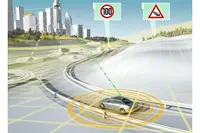Continental’s eHorizon heralds the ‘Internet of Cars’
 Continental is testing its dynamic electronic horizon (eHorizon) on the roads for the first time with demo vehicles. The eHorizon is Continental’s advanced driver assistance system (ADAS), which is designed to provide precise information about road characteristics such as gradients, curve radii, temporary speed limits and other traffic signs, lane changes due to construction work, and other important information.
Continental is testing its dynamic electronic horizon (eHorizon) on the roads for the first time with demo vehicles. The eHorizon is Continental’s advanced driver assistance system (ADAS), which is designed to provide precise information about road characteristics such as gradients, curve radii, temporary speed limits and other traffic signs, lane changes due to construction work, and other important information.
“The Internet will not only extend the selection of on-board infotainment, it will also directly improve the vehicle. The principle behind this is: the better the information base, the safer, more efficient, and more comfortable the vehicle,” said Ralf Lenninger, head of System Development, Innovation, and Strategy in Continental's Interior division. “In the future, vehicles will gather extremely accurate, up-to-date, and reliable information about the road network in an ‘Internet of cars’, and make this information immediately available to all road users.”
The potential for improvement already includes current ADAS such as adaptive cruise control, and will also support the gradual approach towards automated driving. In the future, these improvements will allow the eHorizon to make an accurate assessment of a route, stating whether highly or fully automated driving is suitable for the upcoming route.
Continental is testing the reliability of the eHorizon and its various applications in a series of demo vehicles. The vehicles are connected to Continental's backend platform via a mobile radio module, allowing data exchange in both directions. The on-board systems thereby constantly receive updated route and surroundings information such as additional topographical data or temporary speed limits.
The connected vehicles can also feedback information from their own sensors and on-board systems to the cloud. In doing so, the vehicles make their own contribution to constantly improving and updating the map material and the additional information. Continental developers are using this ‘swarm’ principle as a basis for numerous intelligent applications.
“The eHorizon allows Continental to offer a solution with which vehicle manufacturers can perfect their ADAS options, future drive technologies, and traffic concepts,” says Lenninger. “The high-performance backend system ensures that all users of this technology benefit from the up-to-date and increasingly detailed route data while also actively contributing to improving the accuracy and data quality of this information.”
Continental says trucks have been using the static eHorizon since 2012. They use data from eHorizon to adjust their engine power based on the altitude profile of a route, which according to Continental saves an average of 1500liters of diesel per year. The eHorizon can also provide information to hybrid vehicles with at least a 48V system, allowing the drive system to be used as efficiently as possible. Fully electric vehicles can use the information from the eHorizon in order to calculate their range in advance. Vehicles with adaptive cruise control can use the data to adjust their speed for variable speed limits or curve radii, meaning that drivers only need to steer.
The eHorizon also enables functions such as the Augmented Reality head-up display. The exact information on the course of the road is used to generate the augmentation display, for example a navigation arrow in the head-up display appears as if it was painted directly on the road.
Author
Tom Austin-Morgan
Source: www.newelectronics.co.uk
 Continental is testing its dynamic electronic horizon (eHorizon) on the roads for the first time with demo vehicles. The eHorizon is Continental’s advanced driver assistance system (ADAS), which is designed to provide precise information about road characteristics such as gradients, curve radii, temporary speed limits and other traffic signs, lane changes due to construction work, and other important information.
Continental is testing its dynamic electronic horizon (eHorizon) on the roads for the first time with demo vehicles. The eHorizon is Continental’s advanced driver assistance system (ADAS), which is designed to provide precise information about road characteristics such as gradients, curve radii, temporary speed limits and other traffic signs, lane changes due to construction work, and other important information.